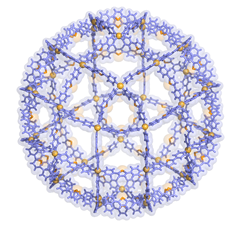Chemistry at the Frontiers
Self-assembly of Archimedean/Non-Archimedean Solids under Mathematical Restriction
Makoto Fujita
The University of Tokyo
Abstract : We and others have been intensively studying the self-assembly of coordination polyhedra whose framework topologies are described by Platonic or Archimedian solids.[1] The largest structure we have synthesized is M30L60 icosidodecahedron, one of the Archimedian solids.[2] Here, we unexpectedly obtained another M30L60 polyhedron that is NOT depicted in any elementary geometry textbook. Triggered by this observation, we mathematically rationalized the unexpected polyhedron based on a theory seldom discussed: the tetravalent Goldberg polyhedra. The common Goldberg polyhedra are made up of hexagons and pentagons with three edges meeting at every node of the polyhedron; well-known real-life examples include footballs and fullerenes. We simply extend this “trivalent” form to generate a new family of “tetravalent” Goldberg polyhedra, made up of squares and triangles.[3] These extended tetravalent Goldberg polyhedra are not described in the literature, presumably because nothing like them has ever been discovered in the real world. However, the square planar geometry of palladium(II) ions has the potential to direct the self-assembly of these unnatural polyhedra, allowing us to synthesize them in the laboratory. We further demonstrate the self-assembly of M48L96 (Figure 1), an extended Goldberg polyhedron, which was predicted by the theory.

Fig. 1. X-ray structure of M48L96 complex
Keywords: Self-assembly, Archimedean Solids, Goldberg polyhedra, Palladium complexes
References:
[1] M. Tominaga, K. Suzuki, M. Kawano, T. Kusukawa, T. Ozeki, S. Sakamoto, K. Yamaguchi, M. Fujita, Angew. Chem. Int. Ed. 2004, 43, 5621-5625.
[2] D. Fujita, Y. Ueda, S. Sato, H. Yokoyama, N. Mizuno, T. Kumasaka, M. Fujita, Chem 2016, 1, 91.
[3] D. Fujita, Y. Ueda, S. Sato, N. Mizuno, T. Kumasaka, M. Fujita, Nature 2016, 540, 563.
Biography
Makoto Fujita graduated from Chiba University (M. Eng., 1982) and received his Ph. D. degree from Tokyo Institute of Technology in 1987. After having academic carrier at Sagami Chemical Research Center, Chiba University, Institute for Molecular Science (IMS), and Nagoya University, he moved to University of Tokyo as a full professor in 2002. In 2018, he was concurrently appointed to IMS as Distinguished Professor. He was awarded the titles of Distinguished Honorary Professor from Chiba University (2018) and University Distinguished Professor from University of Tokyo (2019). He is a laureate of Wolf Prize in Chemistry in 2018.
Group website: http://fujitalab.t.u-tokyo.ac.jp/home_e/







